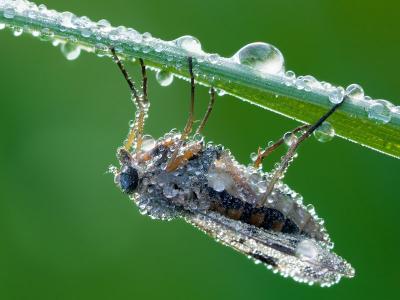University of Montana Assistant Professor John McCutcheon has once again discovered something new about the complex and intriguing inner workings of the cicada insect.
The Proceedings of the National Academy of Sciences recently published his findings online. In a paper titled “Genome expansion by lineage splitting and genome reduction in the cicada endosymbiont Hodgkinia,” McCutcheon and his team found that the nutritional symbionts living inside long-living cicadas have become a lot more complicated. And it’s not necessarily a good thing for the insect.
McCutcheon’s lab examines the symbioses of cicadas, a sap-feeding insect that depends on two bacteria, Sulcia and Hodgkinia, to make amino acids – essential nutrients it needs to survive. In exchange, the bacteria live comfortably inside the cicada. Since all three divvy up the nutritional roles, each member of the symbiosis is completely dependent on the other two for survival. Bottom line: If the insect loses its bacteria, it dies.
Last year, McCutcheon and his team discovered that in some cicadas, the Hodgkinia bacterium had split into two new species. In these insects Sulcia was still there, but they found two different kinds of Hodgkinia. Thus, what previously was thought to be a tripartite, or a three-way symbiosis, is now proven to actually be a four-way symbiosis.
Intrigued by this finding, the researchers dug deeper.
“We thought that this weird bacterial ‘speciation’ event might be related to the unusual lifecycle of the cicada, not of Hodgkinia itself,” McCutcheon said.
Cicadas are unique among insects for their variable and long lifecycles. The shortest-lived cicada has a two-year lifespan, while the longest-lived have 17-year lifespans.
“We guessed that Hodgkinia might have the opportunity to split into more species if it lived in longer-lived cicadas,” McCutcheon said.
That’s exactly what they found. The researchers began by looking at the genome and cell structure of Hodgkinia in the longest-lived cicadas – the periodical cicadas called Magicicada. These are the 13- and 17-year cicadas that occasionally come out in enormous numbers in Central and Eastern U.S. – in fact, there is a huge emergence happening right now.
They discovered that, indeed, Hodgkinia has fragmented into numerous new species, probably on the order of 20 to 50 or so.
“It’s so complicated that it’s tough to get an accurate count right now,” McCutcheon said.
Hodgkinia seems to have created a massive and messy beueaucracy of genomes and cells. While the role of Hodgkinia hasn’t changed, it now takes a collective to accomplish the task of what was once completed by a single cell. In Magicicada, the original functions of Hodgkinia are being partitioned off into smaller jobs and roles. However, many or most of these new genomes remain in separate cells.
What does this mean for the cicada? While the internal bureaucracy of its bacteria has gotten out of hand, it is still reliant upon the symbiosis for survival. Now, it likely needs the entire genome collective to survive. This means that in cicadas, the symbiosis has gone from a three-way partnership to one that involves dozens and dozens of interacting and codependent species.
“We think that this complexity is largely the result of non-adaptive evolution, at least from the host cicada perspective,” McCutcheon said. “It’s difficult to imagine a situation where it’s better for the cicada to have to manage 50 versions of Hodgkinia instead of one. We think that in long-lived cicadas the cicada can’t stop Hodgkinia from splitting, and it either must cope with the changes or the entire symbiosis collapses.”
McCutcheon’s work has implications for the way we think about our own symbionts – such as the power-providing mitochondria in our cells that are the result of a very old bacterial symbiosis – as well as the forces that dictate the structure of genomes in general.
“This wild diversity in genome structure is common in mitochondria, and now we are seeing it in bacterial symbionts, too,” McCutcheon said.
It’s another feature that unites symbionts and organelles, and understanding the development of organelles is fundamental to understanding the development of life. Because organelles arose such a long time ago, it’s impossible to trace back to the specific events that allowed the organelle to become what it is today. By examining Hodgkinia‘s evolution, researchers in McCutcheon’s lab are hoping to gain insight into the storied pasts of organelles whose history has since been erased.


